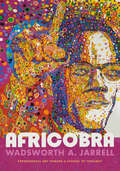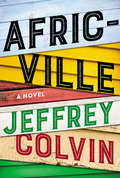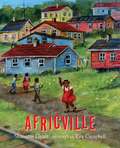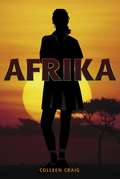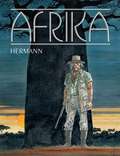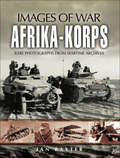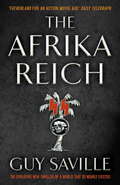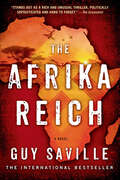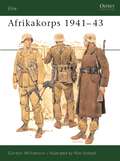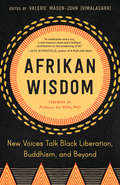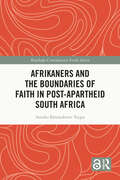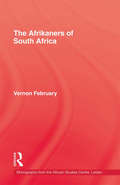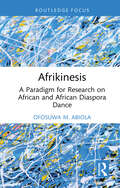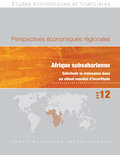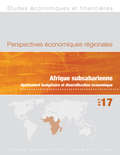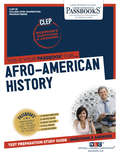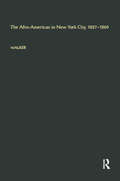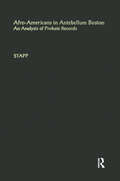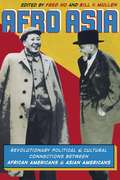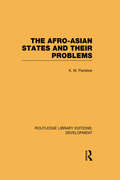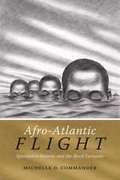- Table View
- List View
Africentric Approaches to Christian Ministry: Strengthening Urban Congregations in African American Communities
by Katie Geneva Cannon Warren L. Dennis J. Deotis Roberts Rosetta E. Ross Gayraud Wilmore Gloria J. Tate Marsha Snulligan Haney Ronald Edward Peters Richard C. Chapple Tumani Mutasa Nyajeka Johnnie Monroe Cain Hope Fielder Fred Douglas SmithIn a pluralistic world where the tendency is to dismiss or silence ethnic and racial differences, Africentric Approaches to Christian Ministry: Strengthening Urban Congregations in African American Communities offers invaluable insight into the ordering of urban congregational life, Christian ministry, and urban missiology from a worldview perspective that values the centrality of African people. Theological leaders and framers of African American religious studies, such as the following persons provide provocative insight for theological reflection and praxis: Gayraud Wilmore (The Black Church); J. Deotis Roberts (Africentric Christianity); Katie Geneva Cannon (Diaspora Ethics); and Cain Hope Fielder (New Testament Studies). The opening and closing chapters by co-editors Ronald Edward Peters and Marsha Snulligan Haney provide a critical knowledge base that frames Africentric Approaches to Christian Ministry. In light of the rapidly changing nature of Christianity globally (non-Western and non-European), this is a significant study on African American religious consciousness and urban praxis.
AfricInvest: A Pan-African Investment Platform
by Victoria Ivashina Youssef Abdel AalThe case is set in December 2018, when Ziad Oueslati, co-managing director and co-founder of AfricInvest, a leading pan-African private equity firm headquartered in Tunisia, was reflecting on the future direction of his firm. AfricInvest started as a traditional small and mid-cap private equity fund, but over the years had expanded into multiple adjoined investment strategies. At the end of 2018, the team saw an opportunity in the venture capital (VC) space, but while some were adamant about the need to raise a VC fund, others were reluctant to add yet another strategy to AfricInvest diverse investment strategies. The case presents a detailed insight into AfricInvest journey from a $10 million Tunisian fund, to becoming a prominent regional player operating throughout the African continent with $1.5 billion of assets under management. Among other issues related to the firm's growth, the case provides insights into the challenges of operating in such a wide and varied geography as the African continent. The case also offers details on their multiple investment strategies, ranging from small-cap SME focused funds, to sector-specific funds, cross-border funds, and private credit. The case explores the synergies and challenges associated with such as wide-reaching investment platform. This is described against the backdrop of the collapse of Abraaj, a leading emerging market private equity firm, in a scandal that shook the investment community in the region. The case also touches upon the role of development finance institutions (DFIs) as investors in emerging markets and the challenges of defining and measuring impact investing. The opportunity of launching a pan-African VC fund in the context of the recent collapse of Abraaj brings to the forefront several strategic questions for AfricInvest's co-founders: Should they keep expanding into new strategies, or would it be better to roll back their existing ones to focus only on their flagship private equity funds?
AFRICOBRA: Experimental Art toward a School of Thought (Art History Publication Initiative)
by Wadsworth A. JarrellFormed on the South Side of Chicago in 1968 at the height of the civil rights, Black power, and Black arts movements, the AFRICOBRA collective created a new artistic visual language rooted in the culture of Chicago's Black neighborhoods. The collective's aesthetics, especially the use of vibrant color, capture the rhythmic dynamism of Black culture and social life. In AFRICOBRA, painter, photographer, and collective cofounder Wadsworth A. Jarrell tells the definitive story of the group's creation, history, and artistic and political principles. From accounts of the painting of the groundbreaking Wall of Respect mural and conversations among group members to documentation of AFRICOBRA's exhibits in Chicago, New York, and Boston, Jarrell outlines how the collective challenged white conceptions of art by developing an artistic philosophy and approach wholly divested of Western practices. Featuring nearly one hundred color images of artworks, exhibition ephemera, and photographs, this book is at once a sourcebook history of AFRICOBRA and the story of visionary artists who rejected the white art establishment in order to create uplifting art for all Black people.
Africville: A Novel
by Jeffrey ColvinFor readers of Lawrence Hill and George Elliott Clarke, a ferociously talented writer makes his stunning debut with this richly woven tapestry. Set in the small Nova Scotia town of Africville, settled by former slaves, Jeffrey Colvin depicts several generations of one family bound together and torn apart by blood, faith, time and fate.A richly woven story, structured as a triptych, Africville chronicles the lives of three generations of the Sebolt family—Kath Ella, her son, Omar/Etienne, and her grandson Warner—whose lives unfold against the tumultuous events of the twentieth century, from the Great Depression of the 1930s, through the social protests of the 1960s, to the economic upheavals of the 1980s.A century earlier, Kath Ella’s ancestors established a new home in Nova Scotia. Like the lives of her ancestors, Kath Ella’s is shaped by hardship as she struggles to conceive and to provide for her family during the long, bitter Canadian winters. She must also contend with the locals’ lingering suspicions about the dark-skinned “outsiders” who live in their midst.Kath Ella’s fierce love for her son, Omar, cannot help her overcome the racial prejudices that linger in this remote, tight-knit place. As he grows up, the rebellious Omar refutes the past and decides to break from the family, threatening to upend all that Kath Ella and her people have tried to build. Over the decades, each successive generation drifts farther from Africville, yet they take a piece of this indelible place with them as they make their way to Montreal, Vermont and beyond, to the deep South of America.As it explores notions of identity, passing, cross-racial relationships, the importance of place and the meaning of home, Africville tells the larger story of the black experience in parts of Canada and the United States. Vibrant and lyrical, filled with colourful details and told in a powerful, haunting voice, this extraordinary novel—as atmospheric and steeped in history as Any Known Blood, The Known World, George & Rue, The Underground Railroad, Homegoing and The Book of Negroes—is a landmark work from a sure-to-be major literary talent.
Africville
by Shauntay GrantWinner of the Lillian Shepherd Memorial Award for Excellence in IllustrationFinalist for a Governor General’s Literary Award, Young People’s Literature – Illustrated BooksFinalist for a Ruth and Sylvia Schwartz Children’s Books AwardWhen a young girl visits the site of Africville, in Halifax, Nova Scotia, the stories she’s heard from her family come to mind. She imagines what the community was once like —the brightly painted houses nestled into the hillside, the field where boys played football, the pond where all the kids went rafting, the bountiful fishing, the huge bonfires. Coming out of her reverie, she visits the present-day park and the sundial where her great- grandmother’s name is carved in stone, and celebrates a summer day at the annual Africville Reunion/Festival.Africville was a vibrant Black community for more than 150 years. But even though its residents paid municipal taxes, they lived without running water, sewers, paved roads and police, fire-truck and ambulance services. Over time, the city located a slaughterhouse, a hospital for infectious disease, and even the city garbage dump nearby. In the 1960s, city officials decided to demolish the community, moving people out in city dump trucks and relocating them in public housing.Today, Africville has been replaced by a park, where former residents and their families gather each summer to remember their community.Key Text Featureshistorical contextreferencesCorrelates to the Common Core State Standards in English Language Arts:CCSS.ELA-LITERACY.RL.K.6With prompting and support, name the author and illustrator of a story and define the role of each in telling the story.CCSS.ELA-LITERACY.RL.1.3Describe characters, settings, and major events in a story, using key details.CCSS.ELA-LITERACY.RL.1.4Identify words and phrases in stories or poems that suggest feelings or appeal to the senses.CCSS.ELA-LITERACY.RL.1.7Use illustrations and details in a story to describe its characters, setting, or events.
Afrika
by Colleen CraigFor thirteen-year-old Kim, travel to South Africa with her journalist mother will mark the end of her childhood and the beginning of a remarkable journey. Expecting nothing more than three months in her mother's homeland, Kim comes to terms with the country's diverse and often shocking history. The Truth and Reconciliation Hearings in post-apartheid South Africa open her eyes to the tragedy and brutality of its segregationist policies. Kim's first meeting with her relatives, her contact with schoolmates and cousins, bring her face-to-face with the realization that she is not as removed from this powerful story as she thought. As her mother struggles with her past, Kim becomes more and more determined to unlock the secret that has always kept her from knowing her father. Helped by the young son of a long-time family servant, whose own father was a casualty of Apartheid history, Kim eventually unlocks her mystery and brings her mother and herself to their own truth and reconciliation. Layered and complex, this is a novel that raises questions and challenges beliefs.From the Trade Paperback edition.
Afrika
by VariousThe masterpiece by Belgian comics creator Hermann is available in English for the first time! A misanthropic European expatriate, Dario Ferrer, acts as guardian of a Tanzanian wildlife preserve. Accompanied by Charlotte, a naive European journalist, Ferrer discovers a village under fire from mysterious agents of the foreign-backed government. Ferrer and Charlotte must fight not only to protect the preserve, but to expose government corruption--and survive to see another day.* From award-winning creator and international bestseller Hermann!* Gorgeous watercolor art and a fast-paced, violent story!
Afrika-Korps: Rare Photographs from Wartime Archives (Images of War)
by Ian BaxterA pictorial history of the Nazi German army expeditionary force deployed to North Africa during World War II between 1941 and 1943.Afrika-Korps is an illustrated record of Field-Marshal Erwin Rommel and his desert troops that fought in North Africa against British and Commonwealth forces between 1941 and 1943. Using previously rare and unpublished photographs, many of which have come from the albums of individuals who took part in the desert campaign, it presents a unique visual account of the famous Afrika-Korps operations and equipment. Thanks to an informative caption with every photograph Afrika Korps vividly portrays how the German Army fought across the uncharted and forbidding desert wilderness of North Africa. Throughout the book it examines how Rommel and his Afrika Korps were so successful and includes an analysis of desert war tactics which Rommel himself had indoctrinated. These tactics quickly won the Afrika-Korps a string of victories between 1941 and 1942. The photographs that accompany the book are a fascinating collection that depicts life in the Afrika-Korps, as seen through the lens of the ordinary soldier.
The Afrika Reich: A Novel
by Guy SavilleWhat if Dunkirk had been the end of Britain's war against the Nazis?'Fatherland for an action movie age.' Daily Telegraph1952. It is more than a decade since humiliation at Dunkirk brought an end to Britain's war and the beginning of an uneasy peace with Hitler.In Africa, the swastika flies from the Sahara to the Indian Ocean. Gleaming autobahns bisect the jungle, jet fighters patrol the skies. The brutal presence of the SS is visible everywhere. Now, however, the demonic plans of Walter Hochburg - architect of Nazi Africa - threaten Britain's ailing colonies.In England, ex-mercenary Burton Cole is offered one last contract. Burton jumps at the chance to settle an old score with Hochburg, despite the protests of the woman he loves. If Burton fails, unimaginable horrors will be unleashed in Africa. No one - black or white - will be spared.But when his mission turns to disaster, Burton is forced to flee for his life. His flight takes him from the unholy killing ground of Kongo to SS slave camps and on to war-torn Angola, finally reaching its thrilling climax in a conspiracy that leads to the dark heart of the Afrika Reich itself.Guy Saville combines meticulous research with edge-of-the seat suspense to produce a superb novel of alternate history.
The Afrika Reich: A Novel
by Guy SavilleFrom Guy Saville, the explosive new thriller of a world that so nearly existedAfrica, 1952. More than a decade has passed since Britain's humiliation at Dunkirk brought an end to the war and the beginning of an uneasy peace with Hitler.The swastika flies from the Sahara to the Indian Ocean. Britain and a victorious Nazi Germany have divided the continent. The SS has crushed the native populations and forced them into labor. Gleaming autobahns bisect the jungle, jet fighters patrol the skies. For almost a decade an uneasy peace has ensued.Now, however, the plans of Walter Hochburg, messianic racist and architect of Nazi Africa, threaten Britain's ailing colonies.Sent to curb his ambitions is Burton Cole: a one-time assassin torn between the woman he loves and settling an old score with Hochburg. If he fails unimaginable horrors will be unleashed on the continent. No one – black or white – will be spared.But when his mission turns to disaster, Burton must flee for his life.It is a flight that will take him from the unholy ground of Kongo to SS slave camps to war-torn Angola – and finally a conspiracy that leads to the dark heart of The Afrika Reich itself.
Afrikakorps 1941-43
by Gordon Williamson Ronald VolstadOsprey's study of the German Afrikakorps of World War II (1939-1945). The campaign in North Africa between September 1940 and May 1943 holds not only an enduring fascination for postwar generations; but also a perhaps unique degree of nostalgia for some surviving participants. The campaign was no less costly in terms of human lives and material than many others; but regret at the cost is accompanied by positive memories in the minds of many veterans. This is not to suggest that the dead have been forgotten; but an almost mystical bond nevertheless exists, even between former enemies, amongst veterans of the desert campaign. Gordon Williamson examines the history, organisation and uniforms of Rommel's Afrikakorps.
Afrikakorps Soldier 1941-43
by Raffaele Ruggeri Pier BattistelliThis book explores the experiences of the German Afrika Korps soldier during the North Africa campaign of World War II (1939-1945), from the Korps' arrival in the North African theater in February 1941 to its eventual surrender in Tunisia in May 1943, with a particular focus on the intense period of warfare in the Western Desert between 1941 and 1942. Under the leadership of one of the war's most famous commanders, Erwin Rommel, the Afrika Korps grew to include a broad range of armor, infantry, artillery, anti-tank, engineer, communication, supply, medical and service elements. The soldiers of the Afrika Korps considered themselves as part of an elite, a highly select group that had no equal, not only in the German Army, but in the rest of the world.
Afrikan Wisdom: New Voices Talk Black Liberation, Buddhism, and Beyond
by Valerie Mason-JohnA spiritual, political, and interdisciplinary anthology of wisdom stories from Black liberation leaders and teachers.Afrikan Wisdom represents an intersectional, cross-pollinated exploration of Black life--past, present, and future. Award-winning author and editor Valerie Mason-John (Vimalasara)'s collection of 34 essays--written by an eclectic and inspirational group of Black thought leaders and teachers--reflects on the unique and multilayered experience of being Black in the world today. This anthology instills in readers the knowledge, awareness, validation, and spiritual tools necessary to nurture both individual and collective liberation. It is both an inspiration and a motivation for Black readers, as well as anyone else interested in reading about emerging spiritual voices. Topics include: • African and Afro-Diasporan cultures, histories, spiritualities, art, music, and literature • Black radical traditions of liberation and consciousness • Anticolonialism and antislavery • Buddhist philosophy • Social and environmental justice • The prison industrial complex and mass incarceration • (Kemetic) yoga, healing, and mindfulness • Intersections with Indigenous cultures • Addiction and recovery • Transgenerational trauma
Afrikaners and the Boundaries of Faith in Post-Apartheid South Africa (Routledge Contemporary South Africa)
by Annika Björnsdotter TeppoThis book examines the shifting moral and spiritual lives of white Afrikaners in South Africa after apartheid. The end of South Africa’s apartheid system of racial and spatial segregation sparked wide-reaching social change as social, cultural, spatial and racial boundaries were transgressed and transformed. This book investigates how Afrikaners have mediated the country’s shifting boundaries within the realm of religion. For instance, one in every three Afrikaners used these new freedoms to leave the traditional Dutch Reformed Church (NGK), often for an entirely new religious affiliation within the Pentecostal or Charismatic churches, or New Religious Movements such as Wiccan neopaganism. Based on long-term ethnographic fieldwork in the Western Cape area, the book investigates what spiritual life after racial totalitarianism means for the members of the ethnic group that constructed and maintained that very totalitarianism. Ultimately, the book asks how these new Afrikaner religious practices contribute to social solidarity and integration in a persistently segregated society, and what they can tell us about racial relations in the country today. This book will be of interest to scholars of religious studies, social and cultural anthropology and African studies.
Afrikaners Of South Africa
by FebruaryFirst Published in 1991. Routledge is an imprint of Taylor & Francis, an informa company.
Afrikinesis: A Paradigm for Research on African and African Diaspora Dance (Routledge Advances in Theatre & Performance Studies)
by Ofosuwa M AbiolaThis book provides scholars and non-specialists alike with a roadmap for effectively conducting culturally aware, historically relevant research on African dance and on any dance style that contains African elements. This book explains why Western research paradigms are inadequate for research on Africana dance. It exposes the value of utilizing an appropriate research paradigm that offers researchers a broader perspective and a transparent, unfettered process for analysis in under-researched topics such as African and African diaspora dance styles. Researchers are introduced to the African dance aesthetic, characteristically African body movements, definitions of steps, understandings within African culture, and a host of other jewels that facilitate a deeper grasp on the subject and refine the quality of the scholar’s research, its findings, and its proficiency. This book will be of great interest to scholars of African dance studies.
Afrique subsaharienne: Entretenir la croissance dans un climat mondial d'incertitude, Avril 12
by International Monetary FundA report from the International Monetary Fund.
Afrique subsaharienne Ajustement budgétaire et diversification économique
by International Monetary FundA report from the International Monetary Fund.
AFRO-AMERICAN HISTORY: Passbooks Study Guide (College Level Examination Program Series (CLEP))
by National Learning CorporationThe College Level Examination Program (CLEP) enables students to demonstrate college-level achievement and earn college credit in various subject areas based on knowledge acquired through self-study, high school and adult courses, or through professional means. The CLEP Afro-American History Passbook® prepares you by sharpening knowledge of the skills and concepts necessary to succeed on the upcoming exam and the college courses that follow. It provides a series of informational texts as well as hundreds of questions and answers in the areas that will likely be covered on your upcoming exam.
The Afro-American in New York City, 1827-1860 (Studies in African American History and Culture)
by George E. WalkerFirst published in 1993. Routledge is an imprint of Taylor & Francis, an informa company.
Afro-Americans in Antebellum Boston: An Analysis of Probate Records (Studies in African American History and Culture)
by Carol Buchalter StappFirst published in 1993. Routledge is an imprint of Taylor & Francis, an informa company.
Afro Asia: Revolutionary Political and Cultural Connetions Between African Americans and Asian Americans
by Fred Ho Bill V. MullenWith contributions from activists, artists, and scholars, Afro Asia is a groundbreaking collection of writing on the historical alliances, cultural connections, and shared political strategies linking African Americans and Asian Americans. Bringing together autobiography, poetry, scholarly criticism, and other genres, this volume represents an activist vanguard in the cultural struggle against oppression. Afro Asia opens with analyses of historical connections between people of African and of Asian descent. An account of nineteenth-century Chinese laborers who fought against slavery and colonialism in Cuba appears alongside an exploration of African Americans' reactions to and experiences of the Korean "conflict. " Contributors examine the fertile period of Afro-Asian exchange that began around the time of the 1955 Bandung Conference, the first meeting of leaders from Asian and African nations in the postcolonial era. One assesses the relationship of two important 1960s Asian American activists to Malcolm X and the Black Panthers. Mao Ze Dong's 1963 and 1968 statements in support of black liberation are juxtaposed with an overview of the influence of Maoism on African American leftists. Turning to the arts, Ishmael Reed provides a brief account of how he met and helped several Asian American writers. A Vietnamese American spoken-word artist describes the impact of black hip-hop culture on working-class urban Asian American youth. Fred Ho interviews Bill Cole, an African American jazz musician who plays Asian double-reed instruments. This pioneering collection closes with an array of creative writing, including poetry, memoir, and a dialogue about identity and friendship that two writers, one Japanese American and the other African American, have performed around the United States. Contributors: Betsy Esch, Diane C. Fujino, royal hartigan, Kim Hewitt, Cheryl Higashida, Fred Ho, Everett Hoagland, Robin D. G. Kelley, Bill V. Mullen, David Mura, Ishle Park, Alexs Pate, Thien-bao Thuc Phi, Ishmael Reed, Kalamu Ya Salaam, Maya Almachar Santos, JoYin C. Shih, Ron Wheeler, Daniel Widener, Lisa Yun
The Afro-Asian States and their Problems (Routledge Library Editions: Development)
by K. M. PanikkarThis reissue of Sandar Panikkar’s 1959 book is based upon a series of lectures given at the Institut d’Etude de Development Economique et Social, which spotlights the problems faced by the multitude of African and Asian states which achieved independence between 1945 and 1957. From Asia, the author discusses the plight of India, Pakistan, Burma, Indonesia, Ceylon, Vietnam, Cambodia, laos, Syria and Lebanon whilst in Africa he assesses the independence of the Sudan, Tunisia, Morroco and Ghana. The problems faced by these countries have many similarities, not least the need to develop systems of political organisation, administrative services necessary for a modern government and the need to completely reorganise their economy.
Afro-Atlantic Flight: Speculative Returns and the Black Fantastic
by Michelle D. CommanderIn Afro-Atlantic Flight Michelle D. Commander traces how post-civil rights Black American artists, intellectuals, and travelers envision literal and figurative flight back to Africa as a means by which to heal the dispossession caused by the slave trade. Through ethnographic, historical, literary, and filmic analyses, Commander shows the ways that cultural producers such as Octavia Butler, Thomas Allen Harris, and Saidiya Hartman engage with speculative thought about slavery, the spiritual realm, and Africa, thereby structuring the imaginary that propels future return flights. She goes on to examine Black Americans’ cultural heritage tourism in and migration to Ghana; Bahia, Brazil; and various sites of slavery in the US South to interrogate the ways that a cadre of actors produces “Africa” and contests master narratives. Compellingly, these material flights do not always satisfy Black Americans’ individualistic desires for homecoming and liberation, leading Commander to focus on the revolutionary possibilities inherent in psychic speculative returns and to argue for the development of a Pan-Africanist stance that works to more effectively address the contemporary resonances of slavery that exist across the Afro-Atlantic.


